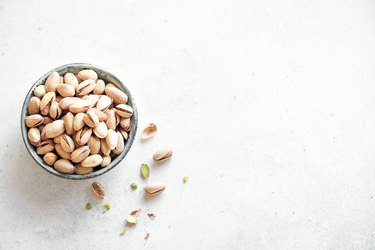
Swapping your go-to snacks for pistachios can make weight loss easier and boost your health. Pistachio serving size, though, is a lot smaller than you think. If you go overboard, you may end up putting on pounds. Enjoy this crunchy snack between meals or when hunger strikes to stay full longer.
Are Pistachios Really Healthy?
Video of the Day
Commonly referred to as the "happy nut," pistachios pack a hefty nutritional punch. They're loaded with protein, fiber and monounsaturated fats as well as vitamins and minerals. Approximately 99 percent of those sold in U.S. stores are produced in California, according to the Agricultural Marketing Resource Center.
Video of the Day
This may come as a surprise, but pistachios are seeds, not nuts. They come from the Pistacia vera L. tree, which belongs to the same family as the poison oak, cashew and mango tree. The word "pistachio" means "the green nut" in Greek, as noted in a review published in the May-June 2016 issue of the journal Food and Nutrition Science. These delicious nuts have been around since 6000 B.C., offering both flavor and nutrition.
Read more: 9 Healthy Nuts That May Help You Live Longer
According to the above review, pistachios may protect against heart disease and improve blood lipids due to their high content of healthy fats. They also promote satiety and may help in weight management.
Furthermore, they may have beneficial effects on blood pressure, digestion and metabolic health. As the scientists note, both almonds and pistachios are natural prebiotics, meaning they feed the good bacteria in your gut and support digestive function.
A research paper featured in the British Journal of Nutrition in July 2015 suggests that pistachios and nut consumption, in general, may lower the risk of cancer, diabetes and inflammatory conditions. Researchers attribute these potential health benefits to the heart-healthy fats and antioxidants in nuts.
Pistachio Serving Size
These crunchy nuts can be a healthy alternative to potato chips, crackers and other popular snacks. Portion control is essential, though. Pistachio serving size isn't an entire cup as many dieters think. According to Food and Nutrition Science, one serving is about 1 ounce, or 30 grams (shelled) — that's about 49 kernels.
Although pistachios are lower in fat than most nuts, they still pack a lot of calories. One serving of dry roasted pistachio nuts provides the following nutrients:
- 162 calories
- 6 grams of protein
- 8 grams of carbs, including 2.9 grams of fiber
- 13 grams of fat
- 11 percent of the daily value (DV) of phosphorus
- 7 percent of the DV of magnesium
- 6 percent of the DV of iron
- 41 percent of the DV of copper
- 16 percent of the DV of vitamin B1
- 19 percent of the DV of vitamin B6
One cup, by comparison, boasts over 700 calories and 56 grams of fat. The calories from nuts are not entirely absorbed into your body, point out several studies in the Food and Nutrition Science review. As it turns, the human gut cannot completely digest the fat in the walls of nut cells. However, you may still gain weight if you take in more calories than you burn.
Read more: The Effects of Overeating Nuts
The same goes for walnuts and other tree nuts, according to the USDA. Only 79 percent of the calories in walnuts, 80 percent of the calories in almonds and 95 percent of the calories in pistachios are absorbed in the body. Therefore, if you eat one serving of pistachios (162 calories), you'll get only 154 calories or less. The difference is negligible, though.
Pistachios and Weight Loss
At first glance, there doesn't seem to be any connection between pistachios and weight loss. However, if you take a closer look at their nutritional content, you'll see they're rich in protein and good fats. Both nutrients aid in weight management and appetite control.
Protein increases satiety and helps preserve lean muscle mass. Plus, it requires more energy to digest and process than other nutrients, due to its high thermic effect. Therefore, pistachios and other high-protein foods can help reduce your energy intake and keep hunger at bay.
Dietary fat has similar effects, reports the journal Food and Nutrition Science. Pistachios are rich in monounsaturated and polyunsaturated fatty acids, which have a higher thermic effect than saturated fats. These nuts are also a good source of fiber, which further enhances satiety.
Remember, moderation is key. Enjoy a handful of pistachios for breakfast, between meals or before bedtime. Mix them with other nuts or sprinkle them over oatmeal, low-carb waffles or pancakes, homemade ice cream, Greek yogurt and other diet-friendly desserts. You can even add them to cooked meals — check out our Red Quinoa with Pistachios recipe for inspiration.
Correction: An earlier version of this story inaccurately identified oak as a member of the same family as pistachios.
- Agricultural Marketing Resource Center: "Pistachios"
- Food and Nutrition Science: "Pistachios for Health"
- British Journal of Nutrition: "Nutrition Attributes and Health Effects of Pistachio Nuts"
- USDA: "Dry Roasted Pistachio Nuts"
- USDA: "Walnuts Have Fewer Calories Than the Label Suggests, ARS Researcher Discovers"
- British Journal of Nutrition: "Dietary Protein – Its Role in Satiety, Energetics, Weight Loss and Health"
- Nutrition & Metabolism: "A High-Protein Diet for Reducing Body Fat: Mechanisms and Possible Caveats"
- Mayo Clinic: "Dietary Fiber: Essential for a Healthy Diet"
- Plants for a Future: "Pistacia vera - L."